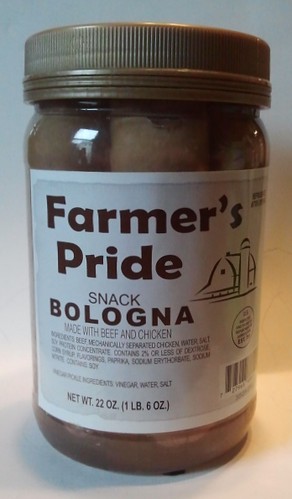 Late last week, I got a heads-up from Steve Wood, who writes Connecticut Museum Quest, a top-notch Connecticut blog that is about so much more than just museums. He alerted me to a new product at Ocean State Job Lot: Farmer's Pride Snack Bologna (which just so happened to be featured in OSJL's "internet coupon" selection.)
Late last week, I got a heads-up from Steve Wood, who writes Connecticut Museum Quest, a top-notch Connecticut blog that is about so much more than just museums. He alerted me to a new product at Ocean State Job Lot: Farmer's Pride Snack Bologna (which just so happened to be featured in OSJL's "internet coupon" selection.)Holy shit, pickled bologna! How could I resist?
Lynnafred found the jars at our local Ocean State. She picked one up - it was the size of a largish peanut butter jar - and peered at the "bologna" within: they were in the form of huge, fat Vienna sausages (and according to the ingredient panel, they're composed of pretty much the same stuff.) The jars were plastic and sealed with soft plastic lids, and as Lynnafred looked through the brine at the bologna she said, "Eww. These are grey. Are they supposed to look like that?" After looking at a dozen other jars, and finding all of them containing somewhat greyish weiners sealed within, we concluded that the answer was probably Yes, they are supposed to look like that. The coupon said that there was a limit of 12 jars per family, but we curbed our enthusiasm and held ourselves to the purchase of a single jar which, at $1.20, seemed to be a fair price.
Let me start the actual review by saying that I can not believe that Farmer's Pride pickled bologna is a regularly-produced consumer good. Every single component of this product screams "DISPOSE OF CHEAP SHIT!!" The jars are flimsy plastic, the lids seem to be made of the same quality plastic as imported dollar-store toys from China, the labels look like they were run off on a laser printer. Most of the jars at the store had sticky label residue clinging to the non-labeled areas, telling me that these snacks were probably rejected by the company which originally contracted them, leading the manufacturer to hastily peel the original label and rebrand them for the "remainder market" (i.e. dollar stores and job lot joints like OSJL.) And then, of course, there is the actual bologna itself:
 That is one nasty-ass piece of tubesteak right there. Check out the gradations of coloring, from a kind of brownish-grey at the ends to rather pinkish in the middle. I swear I used no filtering or image manipulation to change those colors - that is exactly how they come out of the jar. Unfortunately, I wasn't able to capture the true beauty of the grey lines that run from tip to tip on the wieners, especially where the meat was in contact with the sides of the jar. These things are truly ghastly to look at.
That is one nasty-ass piece of tubesteak right there. Check out the gradations of coloring, from a kind of brownish-grey at the ends to rather pinkish in the middle. I swear I used no filtering or image manipulation to change those colors - that is exactly how they come out of the jar. Unfortunately, I wasn't able to capture the true beauty of the grey lines that run from tip to tip on the wieners, especially where the meat was in contact with the sides of the jar. These things are truly ghastly to look at.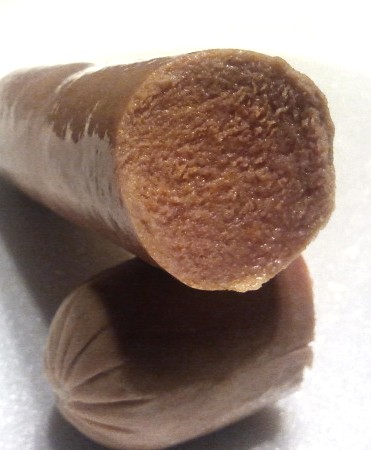 At least when we cut into the wiener we found that the grey color doesn't go all the way through - once you get a little way into the surface, everything kind of turns pink again. I guess that means that they're okay to eat. Honestly, eyeballs are all we have to go by for safety, because there are absolutely no olfactory cues here. No scent of spices, no aroma of meat - nothing at all except the pungency of strong vinegar stabbing at our nostrils like fleets of aromatic daggers. The manufacturer (Monogram Meat Snacks LLC, USDA EST 795) could not possibly have made the brine any more unpleasantly sharp.
At least when we cut into the wiener we found that the grey color doesn't go all the way through - once you get a little way into the surface, everything kind of turns pink again. I guess that means that they're okay to eat. Honestly, eyeballs are all we have to go by for safety, because there are absolutely no olfactory cues here. No scent of spices, no aroma of meat - nothing at all except the pungency of strong vinegar stabbing at our nostrils like fleets of aromatic daggers. The manufacturer (Monogram Meat Snacks LLC, USDA EST 795) could not possibly have made the brine any more unpleasantly sharp.And the wieners are just as unpleasant to eat as they are to look at. The texture is firm and smooth, but there is little flavor beyond the powerful vinegar brine, which is so acidic that it actually produces a burning sensation in the mouth and throat. And - worst of all to me - the meat leaves a disgusting tallowy film coating the mouth and tongue. These things are grossly misnamed - they should be called "Farmer's Shame."
 As with so many other oddball snacks we've tried over the years, Farmer's Pride Snack Bologna proved to be pretty popular with the dogs, though I didn't dare give them all they wanted due to the acidity of the pickle (the last thing I want to do is spend an afternoon scrubbing dog puke out of the dining room rug.)
As with so many other oddball snacks we've tried over the years, Farmer's Pride Snack Bologna proved to be pretty popular with the dogs, though I didn't dare give them all they wanted due to the acidity of the pickle (the last thing I want to do is spend an afternoon scrubbing dog puke out of the dining room rug.)So there you have it. Cheap, shitty, only marginally edible, and obviously close to the end of its shelf life - Look for 'em at a dollar store near you - and pass them up in favor of almost anything else you find.
.
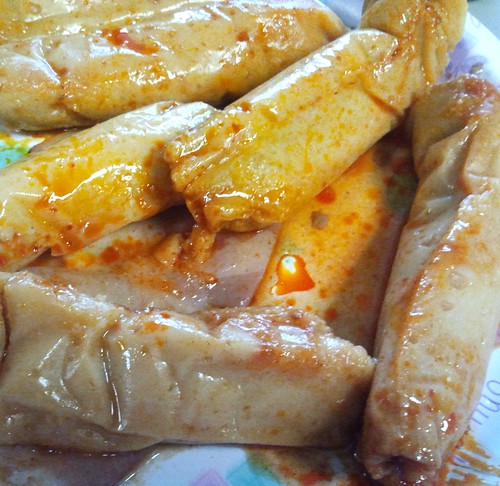
 The pale- and incredibly foul-looking cylinders of evil pictured above are the contents of a can of Senora Verde Beef Tamales, directly as emptied onto a paper plate. Some of them retained their paper sleeves as the can was tipped, others slipped from them like vile giant larvae shedding their outgrown skin. They were supposedly packed in "sauce," but that proved to be merely a watery tomato-flavored bile with a thick film of bright red grease floating on top. The "sauce" was easily disposed of, but globs of the grease stuck sort of randomly to everything else (including the plate, my fingers, and the walls of the microwave when I heated up this mess at work.)
The pale- and incredibly foul-looking cylinders of evil pictured above are the contents of a can of Senora Verde Beef Tamales, directly as emptied onto a paper plate. Some of them retained their paper sleeves as the can was tipped, others slipped from them like vile giant larvae shedding their outgrown skin. They were supposedly packed in "sauce," but that proved to be merely a watery tomato-flavored bile with a thick film of bright red grease floating on top. The "sauce" was easily disposed of, but globs of the grease stuck sort of randomly to everything else (including the plate, my fingers, and the walls of the microwave when I heated up this mess at work.) Single-serve frozen lasagna is one of my favorite lunches, and I'm always looking for new brands to try. So naturally, I grabbed a couple of boxes of Mendelsohn's Lasagna when I found it at The Barn in Greenfield MA.
Single-serve frozen lasagna is one of my favorite lunches, and I'm always looking for new brands to try. So naturally, I grabbed a couple of boxes of Mendelsohn's Lasagna when I found it at The Barn in Greenfield MA.
 My only previous experience with turtle soup was the poem in Lewis Carroll's Alice in Wonderland:
My only previous experience with turtle soup was the poem in Lewis Carroll's Alice in Wonderland:
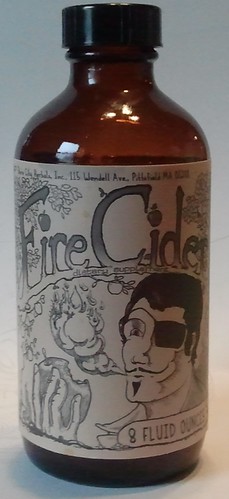 Fire Cider is a sort of traditional herbal folk remedy. If you listen to herbal medicine enthusiasts, you'll come away thinking that a daily dose of the stuff will turn you into superman. A quick Google search will reveal a bunch of recipes for whipping up a batch or two...or, if you live close to the hill towns of Western Massachusetts, you can get it from Shire City Herbals in Pittsfield. The bottle pictured at right is from Shire City. I bought it at The Big E from a pleasant young man who had set up shop on a rainy Thursday night right outside the Massachusetts Building at the fair.
Fire Cider is a sort of traditional herbal folk remedy. If you listen to herbal medicine enthusiasts, you'll come away thinking that a daily dose of the stuff will turn you into superman. A quick Google search will reveal a bunch of recipes for whipping up a batch or two...or, if you live close to the hill towns of Western Massachusetts, you can get it from Shire City Herbals in Pittsfield. The bottle pictured at right is from Shire City. I bought it at The Big E from a pleasant young man who had set up shop on a rainy Thursday night right outside the Massachusetts Building at the fair.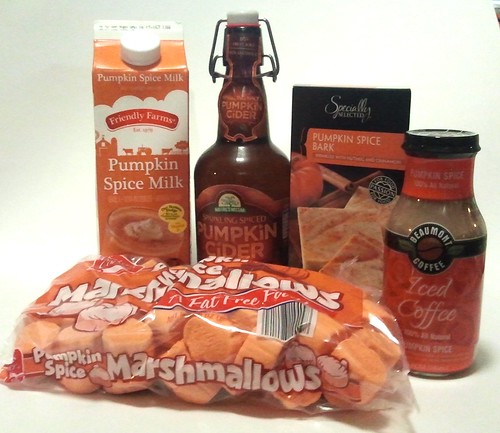

 "The conversation regarding what constitutes the ideal diet for optimal wellness and longevity is an ongoing and exhausting debate. Experts from each respective dietary camp have a plethora of data pointing to their case for why their particular system is the gold standard. But so far, this ongoing debate has not been productive for the general public. There seems to be more confusion than ever before. Perhaps this is because a one-size-fits-all approach does not work.
"The conversation regarding what constitutes the ideal diet for optimal wellness and longevity is an ongoing and exhausting debate. Experts from each respective dietary camp have a plethora of data pointing to their case for why their particular system is the gold standard. But so far, this ongoing debate has not been productive for the general public. There seems to be more confusion than ever before. Perhaps this is because a one-size-fits-all approach does not work. The discussion kicked off with Dr. Lynda Frassetto, internist and kidney specialist at UCSF Medical Center. Frasetto focused on the benefits of a low-acid diet, consisting of vegetables, some fruits, nuts, and lean meat, as a beneficial solution for people with Type 2 diabetes and for optimal kidney health. She presented her research on the benefit of a low-acid Diet (Paleolithic-like), concluding that even short-term consumption of a Paleolithic-like diet "improves blood pressure and glucose tolerance, decreases insulin secretion, increases insulin sensitivity and improves lipid profiles without weight loss in healthy sedentary humans."
The discussion kicked off with Dr. Lynda Frassetto, internist and kidney specialist at UCSF Medical Center. Frasetto focused on the benefits of a low-acid diet, consisting of vegetables, some fruits, nuts, and lean meat, as a beneficial solution for people with Type 2 diabetes and for optimal kidney health. She presented her research on the benefit of a low-acid Diet (Paleolithic-like), concluding that even short-term consumption of a Paleolithic-like diet "improves blood pressure and glucose tolerance, decreases insulin secretion, increases insulin sensitivity and improves lipid profiles without weight loss in healthy sedentary humans." The second presentation was by Dr. Stephen Phinney, Professor of Medicine Emeritus at UC-Davis. Dr. Phinney presented his view on "The Art and Science of Nutritional Ketosis." Phinney defined the meaning of true nutritional ketosis as your body reaching a state of utilizing ketones for fuel in the brain and muscles instead of carbohydrates. This diet trend has become popular with a number of high-performance athletes and ultra-marathon runners who become ketoadaptive and burn ketones as their primary fuel source. Phinney's research on low-carbohydrate living showed that a very-low-carbohydrate diet had two major effects: (1) a reduction in plasma-saturated fatty acids despite a high intake of fat, and (2) a decrease in overall inflammation. According to Phinney, both of these results are beneficial for prevention and reversal of metabolic syndrome.
The second presentation was by Dr. Stephen Phinney, Professor of Medicine Emeritus at UC-Davis. Dr. Phinney presented his view on "The Art and Science of Nutritional Ketosis." Phinney defined the meaning of true nutritional ketosis as your body reaching a state of utilizing ketones for fuel in the brain and muscles instead of carbohydrates. This diet trend has become popular with a number of high-performance athletes and ultra-marathon runners who become ketoadaptive and burn ketones as their primary fuel source. Phinney's research on low-carbohydrate living showed that a very-low-carbohydrate diet had two major effects: (1) a reduction in plasma-saturated fatty acids despite a high intake of fat, and (2) a decrease in overall inflammation. According to Phinney, both of these results are beneficial for prevention and reversal of metabolic syndrome. Dr. Ornish is renowned for the success of his program in reducing not only biomarkers such as cholesterol, but also actual prevention and reversal of heart disease. He also directed the first randomized controlled trial demonstrating that comprehensive lifestyle changes may slow, stop or even reverse the progression of early-stage prostate cancer. The Ornish program is the first lifestyle program to be covered by Medicare- - a huge win for the wellness, nutrition, and preventative medicine communites.
Dr. Ornish is renowned for the success of his program in reducing not only biomarkers such as cholesterol, but also actual prevention and reversal of heart disease. He also directed the first randomized controlled trial demonstrating that comprehensive lifestyle changes may slow, stop or even reverse the progression of early-stage prostate cancer. The Ornish program is the first lifestyle program to be covered by Medicare- - a huge win for the wellness, nutrition, and preventative medicine communites. 



 The program "is intended to help millions of Americans purchase affordable health insurance, reduce unreimbursed usage of hospital and other medical facilities by the uninsured and thereby lower medical expenses and premiums for all," the Obama administration says in the regulation. An accompanying media fact sheet issued Nov. 30 referred to "contributions" without detailing the total cost and scope of the program.
The program "is intended to help millions of Americans purchase affordable health insurance, reduce unreimbursed usage of hospital and other medical facilities by the uninsured and thereby lower medical expenses and premiums for all," the Obama administration says in the regulation. An accompanying media fact sheet issued Nov. 30 referred to "contributions" without detailing the total cost and scope of the program. Word started getting out in the spring, said Young, but hard cost estimates surfaced only recently with the new regulation. It set the per capita rate at $5.25 per month, which works out to $63 a year.
Word started getting out in the spring, said Young, but hard cost estimates surfaced only recently with the new regulation. It set the per capita rate at $5.25 per month, which works out to $63 a year.